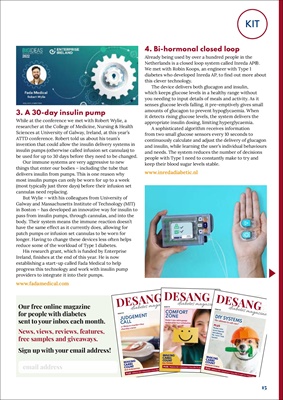
15
KIT
3. A 30-day insulin pump
While at the conference we met with Robert Wylie, a
researcher at the College of Medicine, Nursing & Health
Sciences at University of Galway, Ireland, at this year's
ATTD conference. Robert told us about his team's
invention that could allow the insulin delivery systems in
insulin pumps (otherwise called infusion set cannulas) to
be used for up to 30 days before they need to be changed.
Our immune systems are very aggressive to new
things that enter our bodies - including the tube that
delivers insulin from pumps. This is one reason why you
can only wear most insulin pumps can only be worn for
up to a week (most typically just three days) before their
infusion set cannulas need replacing.
But Wylie - with his colleagues from University of
Galway and Massachusetts Institute of Technology (MIT)
in Boston - has developed an innovative way for insulin to
pass from insulin pumps, through cannulas, and into the
body. Their system means the immune reaction doesn't
have the same effect as it currently does, allowing for
patch pumps or infusion set cannulas to be worn for
longer. Having to change these devices less often helps
reduce some of the workload of Type 1 diabetes.
His research grant, which is funded by Enterprise
Ireland, finishes at the end of this year. He is now
establishing a start-up called Fada Medical to help
progress this technology and work with insulin pump
providers to integrate it into their pumps.
www.fadamedical.com
4. Bi-hormonal closed loop
Already being used by over a hundred people in the
Netherlands is a closed loop system called Inreda AP®.
We met with Robin Koops, an engineer with Type 1
diabetes who developed Inreda AP, to find out more about
this clever technology.
The device delivers both glucagon and insulin,
which keeps glucose levels in a healthy range without
you needing to input details of meals and activity. As it
senses glucose levels falling, it pre-emptively gives small
amounts of glucagon to prevent hypoglycaemia. When
it detects rising glucose levels, the system delivers the
appropriate insulin dosing, limiting hyperglycaemia.
A sophisticated algorithm receives information
from two small glucose sensors every 10 seconds to
continuously calculate and adjust the delivery of glucagon
and insulin, while learning the user's individual behaviours
and needs. The system reduces the number of decisions
people with Type 1 need to constantly make to try and
keep their blood sugar levels stable.
www.inredadiabetic.nl
Our free online magazine
for people with diabetes
sent to your inbox each month.
News, views, reviews, features,
free samples and giveaways.
Sign up with your email address!
ISSUE 115
MAKING
CARBS
COUNT
MILK ALTERNATIVES
PLUS Diabetes kit • Giveaways • News (for T1 and T2) • Food News
JUDGEMENT
CALL
10 things to consider when
choosing a meter
PLUS
Who's Zooming who?
An update on digital
health delivery
ISSUE 111
MAKING
CARBS
COUNT
BELL PEPPERS
PLUS Diabetes kit • Giveaways • News (for T1 and T2) • Food News
COMFORT
ZONE
Roche's new micropump:
designed for user satisfaction
PLUS
Dexcom's next
generation G7 sensor ISSUE 119
MAKING
CARBS
COUNT
LUSCIOUS LYCHEES
PLUS Diabetes kit • Giveaways • News (for T1 and T2) • Food News
DIY SYSTEMS
The ultimate in self-care?
PLUS
Roche's new
meter launch:
introducing
the Accu-Chek
Instant
email address